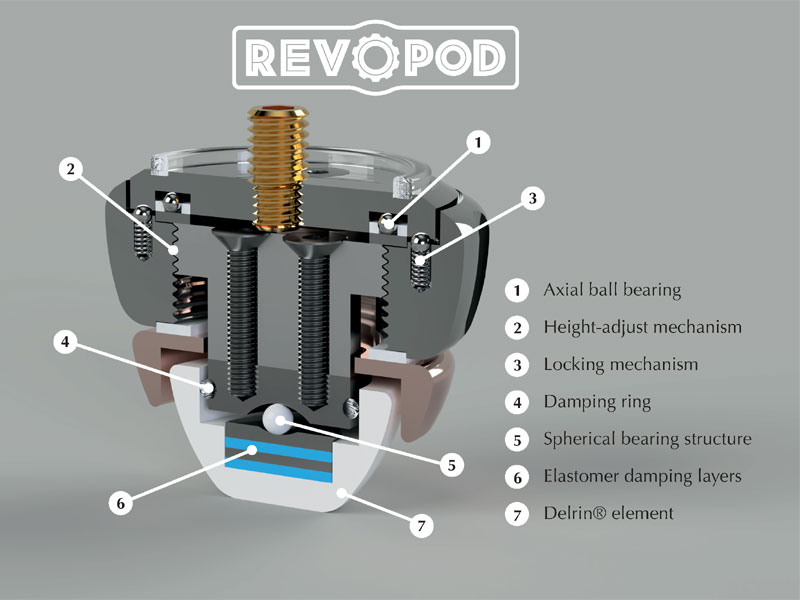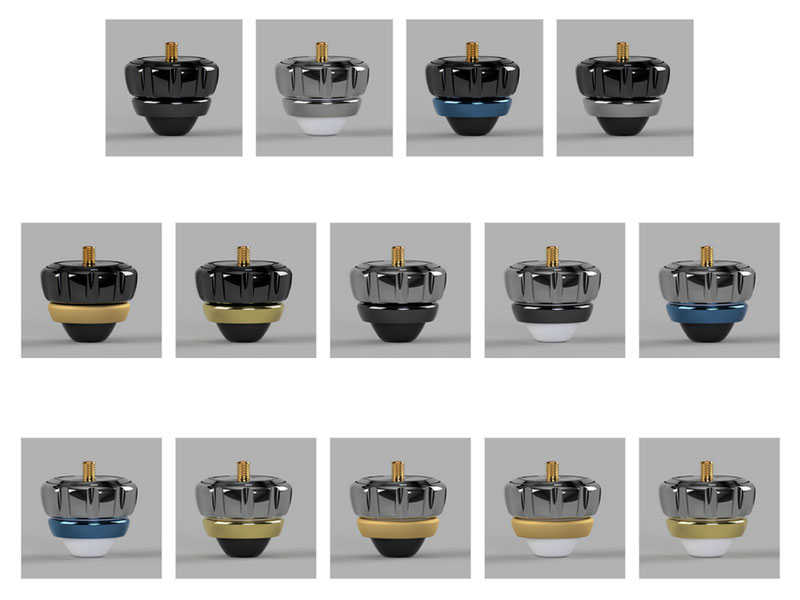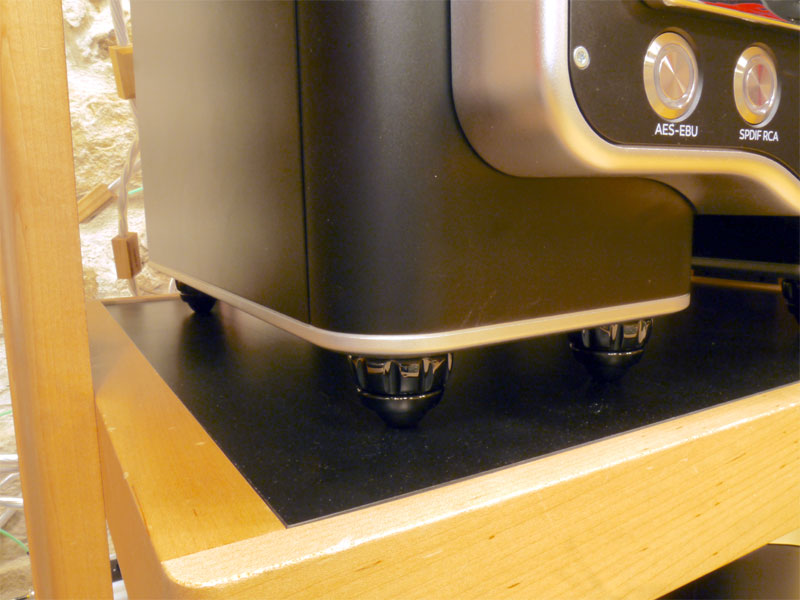First Sounds: Arya Audio RevOpods
he audio industry at large has been slow to catch on and even slower to catch up: What you sit your equipment on matters, and what sits between it and what it sits on matters even more. With increasingly expensive racks littering the market, the high-profile, mainstream support manufacturers seem firmly bogged down in the equipment-isolation swamp, forgetting or ignoring the simple fact that what needs isolating isn’t the equipment but the signal -- and that’s inside the equipment. Couplers, designed to drain the self-generated energy out of electronics and into the supporting structure certainly exist, but despite their easily demonstrable sonic and musical impact, they are essentially simple, one-shot designs to which little further thought has been given. The HRS Nimbus and Vortex footers, Nordost’s SortKone and the Grand Prix Audio Apex are all extremely effective -- or can be if you use them properly. They are also, in practical terms at least, incredibly basic and embody obvious limitations in use. The SortKones are way tall, the Nimbus's contact area so large that the footer is difficult to place under anything but a completely smooth base plate, while the ceramic balls that sit in the peak of the Apex allow equipment to slide or skid once it’s perched on top of them. Various fixes exist for at least some of these shortcomings, but they all compromise performance. But what nobody has done is incorporate an effective, reliable, finely tunable leveling facility into a coupler that really works -- and that matters because when it comes to equipment support, leveling is next to Godliness. Which brings me to Arya Audio’s RevOpod couplers. I first experienced these neat little devices used in conjunction with the Wadax Reference DAC and transport, a combination of equipment and coupler that’s highly rated by Wadax owners. Having tried it, I can both understand their enthusiasm and appreciate the RevOpod’s many virtues -- and (the considerable sonic and musical benefits aside) chief amongst them is a leveling action that’s as smooth and precise as the complication in a Swiss watch.
So what exactly is a RevOpod and what makes it so different? Outwardly, the Arya Audio coupler looks like a heavily profiled but otherwise fairly conventional, blunt cone of the type familiar to audiophiles the world over. But look closer and you discover that it is a miniature piece of precision engineering that embodies both a dispersive cascade structure to lead energy away from the upper interface and threaded internals that allow you to raise or lower the foot element. Starting at the top, a disc that’s roughly 1” in diameter is centrally tapped to take a range of threaded adapters that will allow you to firmly secure the RevOpod to the unit it’s supporting (Arya Audio supplies M6, M8 and 1/4-20 adapters as standard, but other sizes are also available, with M4, M10 and 10/32 all proving popular). This top disc is surrounded by a heavily knurled ring that can be easily and smoothly turned, even when the footer is loaded (although with really heavy units it is worth unweighting the RevOpod during adjustment). Turning the adjuster ring drives a really fine central thread that raises or lowers a central post. That post, in turn, is tipped at its bottom end with a ceramic ball that rests on a bed of elastomer layers, stacked within the blunt Delrin "nose" on which the RevOpod stands. Despite its complexity, the footer stands only 32mm high, with 5mm of available adjustment. Other significant numbers include a load rating of 120kg for a set of four and 0.05mm adjustment steps marked by soft-click detents. RevOpods are available in different, parti-colored finishes, assembled out of gloss black or black chrome metalwork, with the option of blue, matte, or shiny gold lower ring and white or black Delrin nose. Out of that lot you should be able to get something to match your equipment and/or décor, although I really liked the solid-black examples I received. The black and chrome standard finish weighs in at $1200 for a set of four, with the other, premium colors at $1295. Given the engineering involved and the fit and feel of the product and the cost of the competition, those prices seem far from extravagant.
Like any such device, RevOpods respond to careful installation, and it’s here that the few limitations start to emerge. Arya Audio suggest that you can use the RevOpods as freestanding supports and also supply silicon discs or rings to fit between the RevOpod and the unit you are connecting it to, protecting the underside of the chassis. Rule one -- ditch the silicon. I have yet to find a situation in which the RevOpods sound better with the silicon gaskets in place -- which is hardly surprising as the gaskets form an effective barrier to the passage of the energy you are trying to evacuate. Once you eliminate the silicon, you also render the height adjustment unusable, as the RevOpod simply rotates. In other words, these feet are limited to those situations in which you can attach them to the supported unit. The good news is that the upper face is large enough to secure effective contact and small enough to avoid the screw heads and irregularities that litter the bottom of most products. The other key to maximizing the performance of the RevOpods lies not just in leveling the supported equipment, but in taking considerable care to equalize the loading on each foot. Once you’ve leveled the unit, you can feel that individual loading in terms of the resistance to rotating each adjuster ring. Take the time to get the pressure required to turn each ring exactly even. Do it with the music playing and you should hear the sound snap into focus, the dynamics gain impact and authority. Finally, check the level and loading again after a few days. The RevOpods will have settled slightly (those elastomer stacks compressing, perhaps) and tweaking the settings will further enhance performance. Follow those simple rules and what you’ll hear under the Wadax units is an improvement in focus and dimensionality, a drop in the noise floor, a blacker background and the requisite increase in dynamic range that goes hand in hand with all those things. Colors are richer and more natural, music more emotive and expressive. Swap back to the supplied stainless-steel footers and the performance collapses in on itself, losing body, purpose and presence. That makes the RevOpods a no-brainer for Wadax owners, as widely reported within the Wadax community. So score one for the RevOpods. Except that this is far from the whole story. For starters, the Wadax units ain’t exactly beer-budget products, with even the standard Atlantis DAC and transport hitting the six-figure mark and the Reference units close to doubling that. In this context, spending $1200 on footers is close to being a no-brainer -- even if a complete Reference DAC and transport demands 20 feet -- $6000 total. But perhaps more significantly (at least in terms of assessing performance benefits) Wadax already expends a great deal of cost and effort on their chassis to control and dissipate internal energy. Despite that, the RevOpods are still impressively effective. But how do they impact the performance of units with more conventional construction -- and how do those costs stack up? Having a pair of Simaudio Moon 860A v2 amps on hand presented an almost perfect alternative scenario, with the RevOpods offering a straight-replacement option for the adjustable cones fitted by Simaudio, as well as the opportunity for direct ABA comparisons without laboriously replacing all four feet (and subtly altering the setup) each time. It also gave the RevOpods plenty to get their teeth into. Not only does the 860A v2 feature a massive transformer (a significant source of vibrational energy), but that transformer originates in Canada, and while it is possible and sensible to produce specific 50Hz transformers for European product (where this listening was taking place), there’s still a potential for additional vibration as a result. Given the large internal volumes, big, flat panels and rectangular structure of a traditional power amp like the Moon 860A v2, it is also far harder to deal with the elevated levels of internally generated energy. So in many ways, the 860A v2 represents both a sterner test and a more representative mechanical and cost context for assessing the RevOpods’ performance.
It was no surprise that the RevOpods had an immediate and obvious effect on the musical presentation of the amp. What was surprising was just how musically fundamental the improvements were. As an example, I’ll use Barbirolli’s familiar EMI recording, English String Music [Warner WPCS-28020], a recent UHQCD remaster that really captures the space, immediacy and texture of this analog classic. Played on the 860A v2 fitted with the stock cones (via the excellent Vienna Acoustics Beethoven Baby Grand Reference speakers), the music sounded congealed and flat, with no real sense of the recorded acoustic, instrumental separation or the orchestral layout. The normally intimate string textures were glazed over, but most damaging of all, the tempo was sluggish and lethargic, lacking the tension and drama that makes these performances so compelling. On this showing, the disc would be consigned to the "failed experiment/discard" pile, and that would be a crime. The difference with the unit supported on the RevOpods was astonishing. Whilst the music was the same, the presentation and performance were elevated to a completely new level. Right from the start, the sense of space and the recorded acoustic was obvious, with the elements of the orchestra clearly distributed and located. The pizzicato bass notes that punctuate the opening of the Tallis Fantasia are never the cleanest or most defined -- a function of the recording technology used to capture these 1963 performances, but also the placement of the basses on a tall, hollow riser -- but now they were pitch definite, properly elevated and had a real sense of pluck and release to them. The increases in clarity, dynamic definition and purpose were carried over to the performance as a whole, Barbirolli’s masterful control of pace and tempo ratcheting up the tension in the sustained, hanging notes, building the drama as the music unfolded. It is so often reduced to a pretty but inconsequential piece (the English equivalent of the Barber Adagio), but Sir John tapped into the latent menace and brooding darkness behind the traditional tune, using texture and contrast to evolve and unfurl the triumphant conclusion. With the RevOpods in place, those textures and overlapping string tones, crisp dynamic shifts and the final, slow release were beautifully preserved. It's the difference between the discard pile and a performance that is as captivating as it is compelling. It’s the difference between a great system, a great musical experience and something that (in this instance, with this music) is not much above background noise. Okay, so the chosen disc is both demanding and a worst-case scenario. But playing music that plays to the amp’s strengths simply makes the differences and benefits less obvious but no less important. Play Steve Earle’s Copperhead Road [MCA MCD03426] and the RevOpods don’t just sort out the dense congestion in the mix, their clarity and linearity brought purpose to the playing, underpinning the all-important attitude, brought color and separation to the instruments and expressive range to Earle’s voice. That ability to reveal tonal character and identity, to unravel the harmonics that shade instruments and voices should not be underestimated. Even the rampant Pogues on "Johnny Come Lately" failed to reduce the system to stumbling chaos, the RevOpods maintaining an easy grip on the avalanche of driving energy and myriad instruments -- and that’s no mean achievement. It’s also at the very core of what I like so much about the RevOpods’ contribution to system performance -- their consistent and seemingly effortless grasp of proportion and musical articulation. These are qualities that are important on large-scale, especially orchestral, works. But they are, if anything, even more important on smaller, more intimate pieces. Think solo piano and you’ll hear what I mean -- whether that’s Janis Ian’s "Some Peoples’ Lives" or Maria-João Pires playing Mozart sonatas. In both cases the RevOpods made for a far more intimate, communicative and expressive result -- impressively so. In the context of an amplifier costing well the wrong side of $12,000, spending $1200 for this level of improvement is a no-brainer. It’s not just that the RevOpods are a bargain -- they make the 860A v2 into a pretty significant bargain too. What the RevOpods bring to both the Simaudio Moon amps and the other somewhat reasonably priced electronics that I tried them with, like the Jeff Rowland 625 II amp and the CEC TL-2N transport, is a sense of calm clarity that, far from slowing the music or muting its impact, gets the right amount of musical energy traveling in the right direction at the right time, delivering the band’s intent and the recording’s and system’s potential -- and that’s a point worth underlining. In each case where I employed the RevOpods, the signal chain remained unchanged. In other words, all the footers were doing was delivering the latent potential contained in those expensive electronics we all spend so much money on and time worrying about. Of course, the RevOpods are far from unique in this
regard, and I’ve long relied on the already mentioned HRS Nimbus footers and Nordost
SortKones to do the same job -- albeit each in its own fashion. But three things set the
RevOpods apart: their low stack height, that fabulous leveling facility and the easy order
they bring to music, along with the subtlety with which they reveal tonal color and
harmonics. The SortKones are more dynamic and musically emphatic, the Nimbus more stable
and even more dimensionally explicit, but the RevOpods’ balance of virtues, and the
overall musical coherence that results, moves them to the head of the list where footers
are concerned. That doesn’t make them the best option in every case, but where they
can be firmly attached to the unit in question (and there’s a wide range of adapters
available) it definitely makes them first up to try. |



